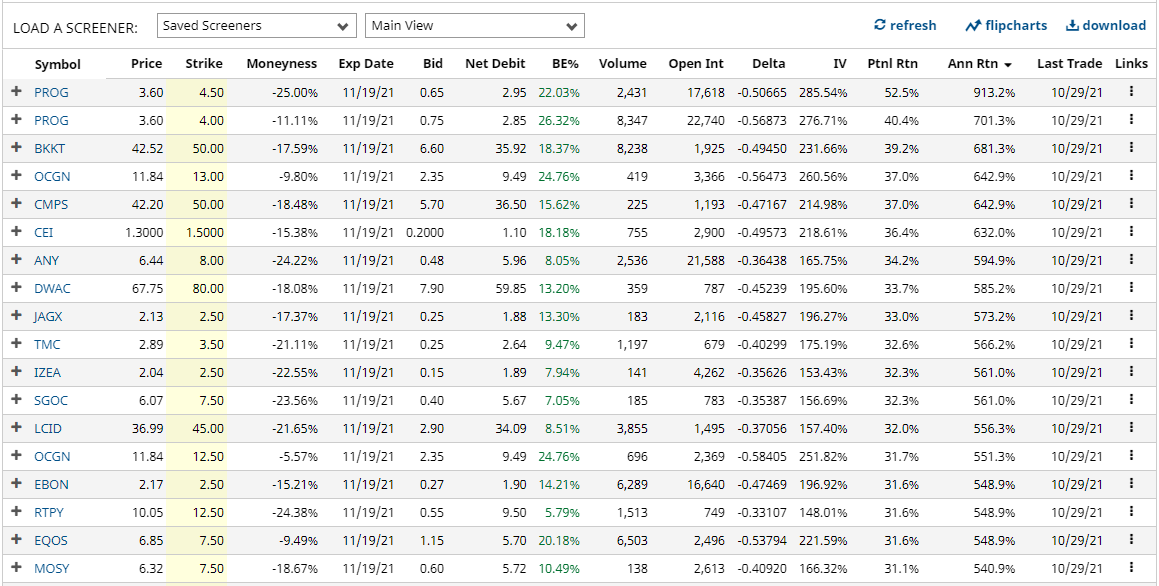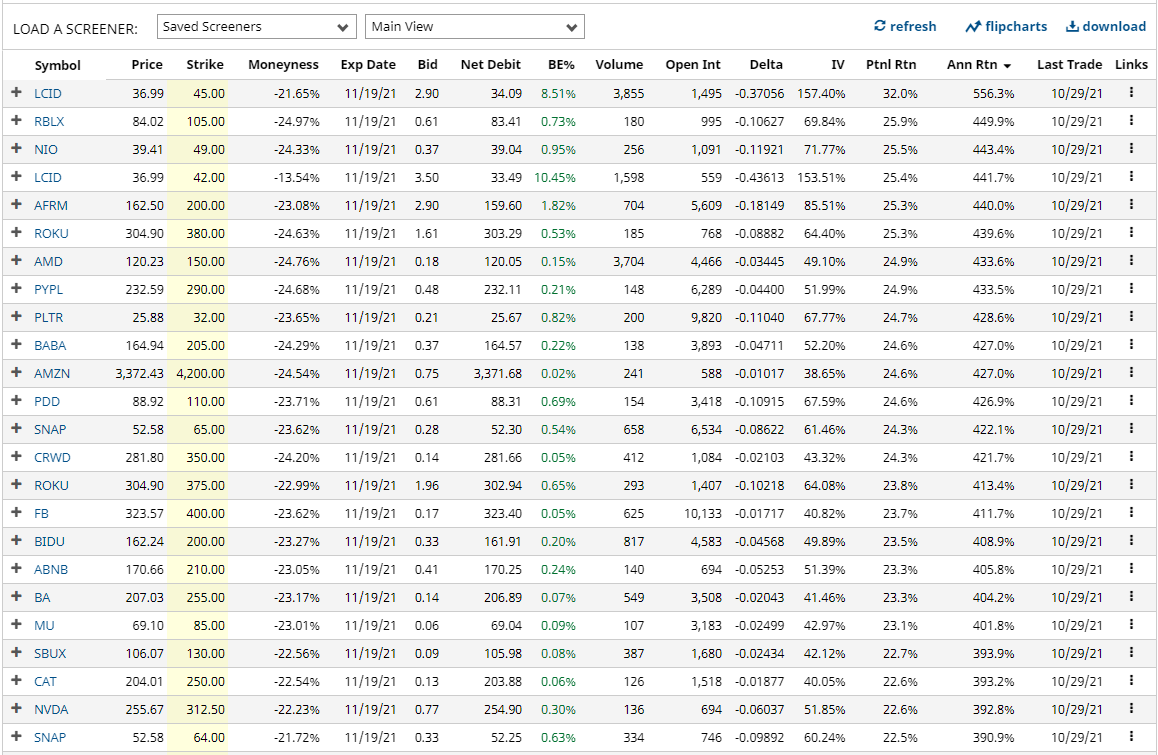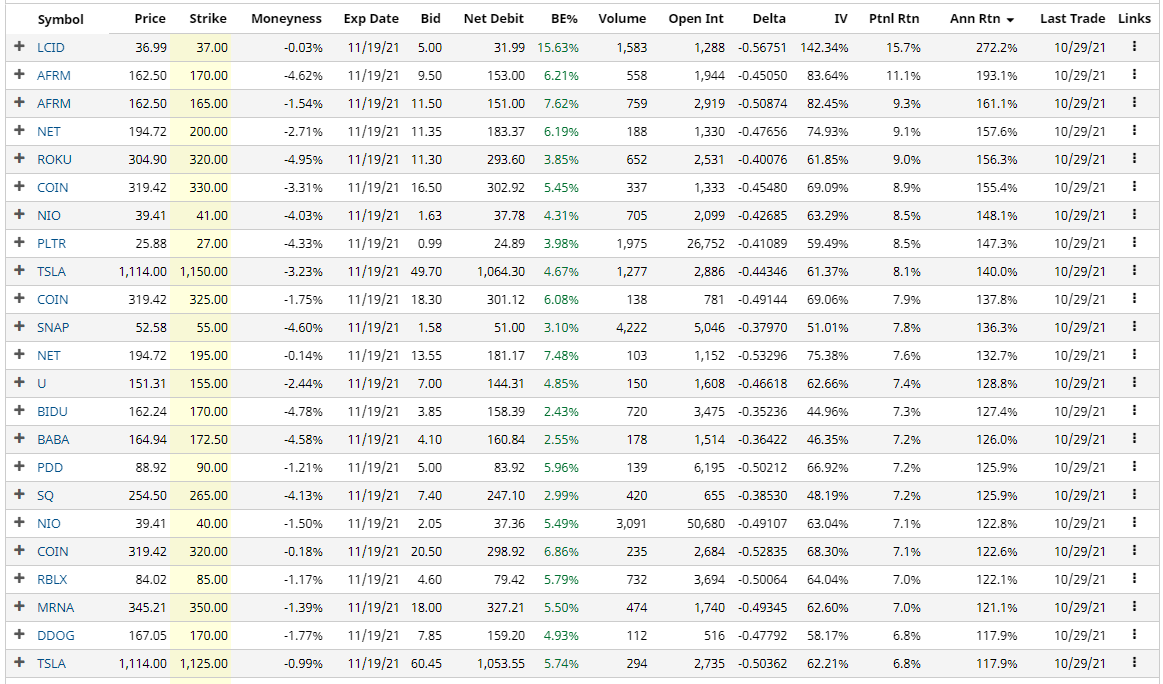Paypal Holdings(PYPL-Q)NASDAQ
Covered Call Screener Results for November 1st
Covered calls are a great strategy to add to any portfolio, particularly in this era of low yields. Covered calls can offer enhanced yield from stock holdings, in some case, that can be a significant increase.
To trade a covered call we need to own (or buy) 100 shares of a stock and then sell a call option against that stock position.
The goal is to generate income from the stock holding in addition to any dividends. The premium received from selling the call also covers a small decline in the stock price. However, the trade off is that stock gains are limited above the call option strike price.
High volatility stocks have the highest return potential with covered calls, but they also have the highest risk of an adverse price movement. It’s all about finding a strategy that fits the investors risk tolerance.
Let’s look at a few examples using Barchart’s Covered Call Screener.
This first example shows the results of the screener with the default parameters selected.

This result returns some stocks with very low market capitalization and, while the returns look great, the risks can also be very high.
Let’s add a filter for Market Cap over 40 billion.

Now, we’re seeing some more mainstream names such as ROKU, PYPL, AMD, FB and SNAP.
Covered Call Example
Let’s evaluate the trade with the highest return potential. Buying 100 shares of LCID would cost $3,699. The November 45 strike call option was trading on Friday around $2.90, generating $290 in premium per contract for covered call sellers. Selling the call option generates an income of 8.51% in 18 days, equaling around 172% annualized. That assumes the stock stays exactly where it is. What if the stock rises above the strike price of 45? If LCID closes above 45 on the expiration date, the shares will be called away at 45, leaving the trader with a total profit of $1,091 (gain on the shares plus the $290 option premium received). That equates to a 32% return, which is 556% on an annualized basis.
The Barchart Technical Opinion rating for LCID is currently a 56% Buy with a strengthening short-term outlook on maintaining the current direction. The current IV Percentile is 97% which means that the current level of implied volatility is higher than 97% of all occurrences in the last 12 months. LCID is set to report earnings on November 15, so this covered call position would have earnings risk.
Income Focused Covered Call Example
The previous example shows a very nice potential return, but required the stock to rally significantly to achieve the full return. Let’s adjust the screener slightly so that we can find more income focused covered calls. We can do this by changing the Moneyness filter to be -5% to 0%. This will give us covered calls that are closer to at-the-money. This means they will have less capital gain potential and focus mainly on the income portion of the trade.

Here are the results:

Let’s use LCID again as our example.
The November 37 strike call option was trading on Friday around $5.00, generating $500 in premium per contract for covered call sellers.
Selling the call option generates an income of 15.63% in 18 days, equaling around 317% annualized. That return is roughly the same if the shares get called away given the stock price and strike price are basically the same.
Here is another example using Square. Buying 100 shares of SQ would cost around $25,450. Selling the 265 strike call with a November 19 expiration date would generate around $740 in covered call premium.
The total capital at risk would be the $25,450 to buy the 100 shares less the premium received of $740. That equals $24,710.
If we take 740 divided by 24,710, that gives us a potential return of 2.99%. On an annualized basis that is 60.73%.
IF Square closes above 265 on November 19, the shares would be called away and the total return would be equal to the gain on the stock ($1,050) plus the option premium received ($740) for a total gain of $1,790 or 7.24%.
That is around 125.9% annualized.
The Barchart Technical Opinion rating for SQ is currently a 64% Buy with a weakening short-term outlook on maintaining the current direction. The current IV Percentile is 33% which means that the current level of implied volatility is higher than 33% of all occurrences in the last 12 months. SQ is set to report earnings on November 4, so this covered call position would have earnings risk.
Please remember that options are risky, and investors can lose 100% of their investment.
This article is for education purposes only and not a trade recommendation. Remember to always do your own due diligence and consult your financial advisor before making any investment decisions.
*Disclaimer: On the date of publication, Gavin McMaster did not have (either directly or indirectly) positions in any of the securities mentioned in this article. All information and data in this article is solely for informational purposes. Data as of after-hours, Oct 31, 2021.

Provided Content: Content provided by Barchart. The Globe and Mail was not involved, and material was not reviewed prior to publication.